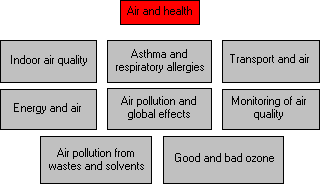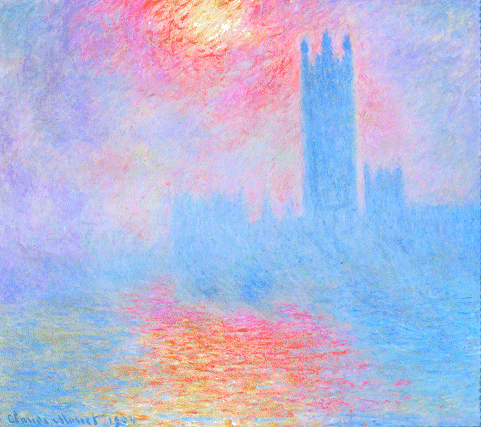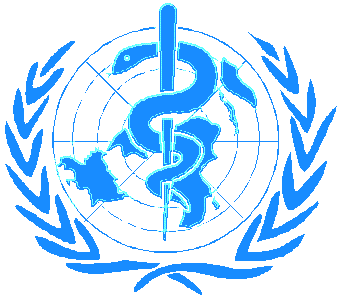 Foreword Foreword
|
|
Air quality is an issue of critical importance for both
health and environment. In 1997, the European Environment Agency published Air pollution
in Europe, a summary of the sources and emissions of major air pollutants. Ten years
earlier, the WHO Regional Office for Europe published the first Air quality guidelines for
Europe. Collaboration between the two institutions on this
subject was natural. This pamphlet on air and health will help promote better
understanding of air quality and its impact on human health. It provides a simple yet
comprehensive introduction to the illnesses induced mainly by air pollutants and briefly
describes their sources.
It also makes three recommendations drafted by the WHO Regional
Office for Europe, which, when implemented, will substantially improve the local
environment and the quality of life of European citizens.
The European Environment Agency's mission is to provide timely, relevant and reliable information to support all those who strive for a more
sustainable and healthy environment. This pamphlet is written for the many professionals
in local authorities in a wide range of disciplines, who help make our cities, schools and
working places safer and more pleasant to be in. If this co-operative effort encourages
local authorities to take fully - informed decisions on air pollution, it will have been
successful.
The WHO Regional Office for Europe and the European Environment
Agency will co-operate again in 1997 to produce a follow-up pamphlet on air quality
monitoring, networks and technologies.
All those who have contributed to this work have performed a
difficult and challenging task. This contribution is fully acknowledged and both of us
should like to express our gratitude for their commitment and willingness to work
together.
Achieving safe, clean air throughout Europe will be difficult:
joining forces will ease the process. |
|
Dr Jo. E Asvall
Regional Director
WHO Regional Office for Europe |
Mr Domingo Jimenez-Beltrán
Executive Director
European Environment Agency |
 Preface Preface
|
|
 This pamphlet deals with common air pollutants, and their health effects. It
provides basic health - related information which will help decision-makers at the local
level, on air quality management. The focus is on health but as air pollution and some of
its causes such as transport contribute to building damage and agricultural or habitat
losses, these impacts will also be discussed briefly. It will be followed by several other
pamphlets in the same series which will provide more details on the problems of air
pollution and on solutions for local authorities. This pamphlet deals with common air pollutants, and their health effects. It
provides basic health - related information which will help decision-makers at the local
level, on air quality management. The focus is on health but as air pollution and some of
its causes such as transport contribute to building damage and agricultural or habitat
losses, these impacts will also be discussed briefly. It will be followed by several other
pamphlets in the same series which will provide more details on the problems of air
pollution and on solutions for local authorities.
In this series, the recommendations are
ranked by priorities, so that strategies can be developed which are appropriate to the
local context.
   marks the recommendations that must be put into effect in order
to ensure a safe and clean environment. All local authorities have a duty to tackle these
tasks immediately. marks the recommendations that must be put into effect in order
to ensure a safe and clean environment. All local authorities have a duty to tackle these
tasks immediately.
  identifies
the recommendations that will yield marked improvements in people's health and should be
regarded as priority actions. identifies
the recommendations that will yield marked improvements in people's health and should be
regarded as priority actions.
 marks the recommendations that will, if they are
implemented, substantially improve the local environment. Everyone's quality of life will
benefit from these. marks the recommendations that will, if they are
implemented, substantially improve the local environment. Everyone's quality of life will
benefit from these.
The unranked recommendations are designed to help you draw up
strategies at local level and will not, in general, have a direct effect on health.
Click here if you want to read the recommendations now
Xavier Bonnefoy, Paolo G. Meozzi, Project coordinators.
|

 Summary Summary
"The air we receive at our birth and resign only when we
die is the first necessity of our existence."
The Times, London, 17 February 1881 |
|
This pamphlet provides an overview of the main air
pollutants, their sources, their main effects on health and the global environment, and
what can be done to reduce them.
During the Industrial Revolution, air pollution was an inevitable accompaniment of
economic development, causing bronchitis and other respiratory diseases.
During the last 40 years or so many countries have introduced laws to control air
pollution from all sources. WHO estimates, however, that about 1.6 billion people
world-wide are still exposed to air which is polluted.
In several parts of the world combustion for domestic heating is still an important source
of air pollution, but in most European countries, industrial emissions and traffic are now
the major sources of concern.
Local authorities therefore have an important role to play in reducing air pollution,
encouraging the adoption of precautionary health measures and disseminating information on
better practices and technologies for achieving air quality objectives.
Further pamphlets in this series will provide more detail on all these subjects, and
particularly on actions that can be taken at local level. |
 The authors The authors
|
|
 Dr Robert Maynard Dr Robert Maynard is a
Senior Medical Officer at the Department of Health where he is the Head of the Air Quality
Science Unit in the Division of Health Aspects of the Environment and Food. He has worked
in respiratory pathology and physiology for almost 20 years and has published papers on
lung injury and inhalation toxicology. |
|
 Mr David Gee Mr David Gee works
at the European Environment Agency, Copenhagen , on information strategy and
implementation. Over the last 25 years he has worked on occupational and environmental
risk reduction, and has written many publications on chemicals, radiation, asbestos,
traffic fumes and scientific uncertainty. |
 Legal notice Legal notice
|
|
© World Health Organization 1997 All rights in this
document are reserved by the WHO regional Office for Europe. The document may be freely
reviewed or abstracted provided due acknowledgement is made to the source. The Regional
Office encourages the translation of this document, but permission must be sought first.
Anyone interested in producing a translated version of this document should therefore
contact WHO Regional Office for Europe, Scherfigsvej 8, DK-2100 Copenhagen, Denmark to
discuss their plans. Any views expressed by named authors are solely the responsibility of
those authors. |
 Acknowledgments
Acknowledgments
|
|
The following people must be thanked for their
collaboration to the development of this document:
Dr Philippe Bourdeau, Chair of the Scientific Committee of the EEA, Dr David Stanners,
EEA, Mr Gordon McInnes, EEA, Copenhagen, Danmark; Mr R. Bouscaren, CITEPA, France; Dr
Michael Krzyzanowski and Dr Rolaf Van Leuwen, WHO European Centre for Environment and
Health, Bilthoven, Netherlands; Pr William Dab, ENSP, Rennes, France; Dr Julius Ptashekas,
Vilnius, Lithuania; Dr G Kamizoulis, WHO Mediterranean Action Plan, Athens, Pr Anthony
Seaton, University of Aberdeen, United Kingdom; Dr D. Schwela, WHO, Geneva, Switzerland;
Dr John G. Ayres, Birmingham Heartlands Hospital, United Kingdom; Dr Vladimira Vadjic,
Institute for Medical Research and Occupational Health, Zagreb, Croatia; Dr Medina,
ERPURS, France; Dr Christina Schatzl, European Commission, DG V, Luxembourg; Dr Canice
Nolan, European Commission, DG XII, D/1, Brussels, Belgium; for their contribution to this
document. Photo credit:
Musée d'Orsay, RMN, H. Lewandowski, Paris; The Guardian; David Rose, London; Agence
Pix, Paris; Agence Explorer, P. Rouchon, Paris; Greenways waste management, London.
Editor: Mrs Loveday Murley, National Society for Clean Air
and Environmental Protection.
Front cover: Mr Roger Laüt.
Design and lay-out: Mr Pierre Finot.
This Web document has been prepared by Mr Emmanuel Briand
(WHO-EURO) |
|
|








Document Actions
Share with others